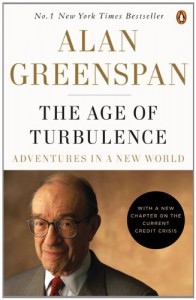19
Followers
4
Following
riteshkala
I am an avid reader and book blogger and live in Mumbai, India. I work in the financial consultancy industry when I’m not reading books. I really like SF and Fantasy!
The Age of Turbulence: Adventures in a New World
 Posted here: http://riteshkala.wordpress.com
Posted here: http://riteshkala.wordpress.comAlan Greenspan, as the head of the Federal Reserve, has been in an enviable position to witness the economic movements of the USA and the rest of the world.
The book is divided into two parts, the first one is a chronological biography, and the second one is his views on the challenges facing the USA and the rest of the world.
I was a bit disappointed with the publishing date of the book (it was published in 2007), as it was before the big global recession. I would have loved to read his views on the downturn, its causes, and his defence against the role he played in creating it, as a number of people have insinuated.
Also a result of having been published earlier, there are a number of views he expresses, with which I now do not agree. He might have changed his views, had he witnessed the huge problems created in the USA.
Some of the views and beliefs expressed in the book with which I disagree include:
1. The current account deficit of the USA may not matter much.
2. Hedge funds should not be regulated as they play an important role in stabilizing markets.
3. Banks can regulate themselves much better than regulators can.
4. Bank employees care for the shareholders, and so limit risk taking.
5. Credit derivatives and mortgage backed securities make markets more efficient and better.
6. Belief that regulation should restricted as much as possible.
7. Belief that bubbles should not be popped.
8. Belief that taking out home-equity loans was beneficial to the economy, and ignoring the risk of defaults.
9. His endorsement for CDS as a way to redistribute risk, but ignoring their use as speculative instruments.
10. Ignoring the risk of increased inter-linkages of financial institutions.
Overall, the biographical section is very interesting, as it provides an insider view on the politics and policy-making of various US governments.
The second section is a bit more general, where he outlines the problems, but refrains from clearly outlining workable solutions which could be implemented in order to overcome these problems.
I found this book to be a quick read, and would recommend it to anyone interested in understanding the workings of the federal reserve and the US government from a practical viewpoint.





